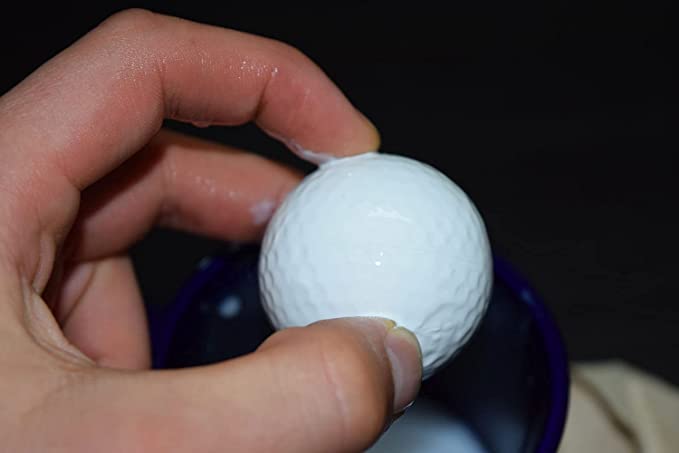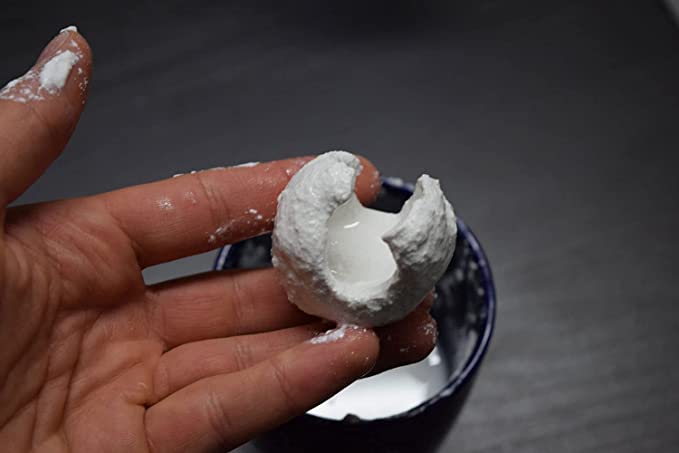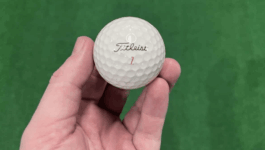According to the Danish Golf Union, a golf ball takes 100 to 1,000 years to decompose. In this post, I reveal the top 3 biodegradable golf balls, which decay faster, reducing their impact on the surrounding ecosystem.
By the end of this post, you will know what makes biodegradable golf balls different from standard constructions and why they are worth considering. In addition, I reveal what to look for in biodegradable golf balls for water before highlighting your 3 best options for greener golf.
Top 3 Biodegradable Balls
| Best Overall | Best Budget | Best Performing | |
| Dixon Wind | Biodegradable Golf Balls | Dixon Fire | |
| Pros |
|
|
|
| Cons |
|
|
|
| Price Score | 84.5 | 86.3 | 72.1 |
| Decomposition | 81.0 | 98.7 | 81.0 |
| Ball Speed | 92.4 | 61.8 | 93.6 |
| Driver Spin | 87.9 | 65.3 | 94.1 |
| Wedge Spin | 80.3 | 61.9 | 92.5 |
| Durability | 88.6 | 79.1 | 83.4 |
| Rating | 4.2 Stars | 3.9 Stars | 3.5 Stars |
Why You Should Trust Us
Our team spends thousands of hours trying out and researching golf equipment to help you take your game to the next level. Here’s our product review process.
We can bring these reviews to you through the small commissions we earn if you buy through the links below.
How We Reviewed These Products
Golfspan only shares equipment and brands we trust.
I’m an experienced golfer of 28 years and thoroughly researched and evaluated the products shared below. Then an editor reviewed and fact-checked the list. Finally, we conduct regular content audits to update and revise our reviews to ensure you receive the latest information.
To select these balls, we considered these criteria:
- Cost
- Decomposition time
- Design
- Speed
- Spin
- Feel
- Distance
Read more: What Golf Ball Should I Use?
The Best Environmentally Friendly Golf Balls
1. Dixon Wind – Overall Best Decomposable Balls
Pros
- Eco-friendly design
- High rebound green core
- Produces rapid ball speed
- Generates low driver spin
- Promotes a higher flight
Cons
- Expensive for distance golf balls
- They still take 40 years to decompose
Specs
- Layers: 2-piece
- Golf Ball Type: Distance
- Cover Material: Surlyn
- Decomposition Period: 40 Years
- Colors: White
Dixon wind golf balls claim the top spot in our biodegradable golf balls review for their distance and straight flight. In addition, the manufacturer employed recyclable materials, an eco-friendly cover, and a green core, lowering the overall carbon footprint of the golf balls.
I was impressed with the overall performance of the 2-piece design, as I found it easy to launch off the tee and on approach. It also generated exceptionally low driver spin, helping me launch the ball high and prompt straighter ball flight.
The speed on the ball was generated by the Densified Precast Green Core, which did well to optimize energy transfer at contact. As a result, the ball sprung off the clubface rapidly on long shots, leading to a high, powerful launch and optimal distance.
Next, Dixon engineers applied an eco-friendly cover to the golf ball, which I found was better suited to a low-spinning shot. Finally, despite being eco golf balls, they take approximately 40 years to completely decompose, half that of a standard golf ball.
Rating: 4.2
2. BiodegradableGolfBalls.com – Best Cheap Biodegradable Golf Balls
Pros
- Affordable compared to other biodegradable balls
- They decompose in 4 weeks
- Ideal for lakeside practice
- Water-soluble golf balls
- Perfect for a novelty gift
Cons
- Not built for game improvement purposes
- Not suited for consistent use during a round
Specs
- Layers: 2-piece
- Golf Ball Type: Novelty
- Cover Material: Polyvinyl Alcohol
- Decomposition Period: 4 Weeks
- Colors: White
Ocean-safe golf balls are not as affordable as 2-piece distance constructions. However, Biodegradable balls offer golfers on a budget, the ability to reduce their environmental impact without breaking the bank.
The Biodegradable corn starch design is not built for optimal performance on the golf course. Therefore, it is not recommended for players seeking game improvement qualities from their golf balls. Instead, it is best suited for hitting into nearby lakes or as a novelty gift.
Despite its lack of optimal performance features, I find the Biodegradable balls offer one of the fastest decaying periods. In one month, these golf balls hit into water will break down and reduce their impact on the surrounding lakes and wetlands.
Finally, our cheapest biodegradable golf balls pick is available in boxes of 12, 24, or 96, which is ideal for lakeside practice.
Rating: 3.9
3. Dixon Fire Golf Balls – Best Performing Disintegrating Golf Balls
No products found.
Pros
- Produces rapid balls speed
- Low long-game spin
- Increased greenside spin
- Eco-friendly design
- Promotes workable flight
Cons
- Priced at a premium
- Takes 40 years to decompose
Specs
- Layers: 3-piece
- Golf Ball Type: Tour
- Cover Material:Cast Urethane
- Decomposition Period: 40 Years
- Colors: White
We close out our best biodegradable golf balls review with the best performing biodegradable golf balls. The Dixon Fire range delivers exceptional ball speed and low driver spin for optimal distance off the tee. Conversely, they increase spin revolutions around the green for better wedge control.
The 3-piece construction is better suited to the fast swing speeds of low handicap golfers, and its corresponding price tag backs this theory up. However, despite its impressive performance, I found the durability was lacking.
I appreciated the work of the High-Intensity green core featuring Ignite Technology, which exploded off the clubface. Thanks to the responsiveness of the core, it boosted energy transfer and caused the ball to spring rapidly and shoot into the air.
Next, the Energy Intensifying Mantle located between the core and cover further accelerated ball velocity on long shots. Finally, I thought the Elastodynamic urethane cover felt soft, doing well to dig into my wedge grooves at impact and promote increased spin revolutions.
My biggest gripe with the Dixon Fire Golf balls is their price tag and lackluster durability. They end up costing significantly more than premium quality balls from Titleist and Bridgestone, leading many to question the value of the extra spend.
Rating: 3.5
Are Biodegradable Golf Balls Any Good?

No, from a performance perspective, biodegradable golf balls are not any good. They are not built for the golf course and provide limited game improvement assistance. They are best used as gifts or hitting into lakes.
In addition, they are relatively expensive compared to legacy brand golf balls, making it difficult to justify the spending.
What To Consider When Purchasing Biodegradable Golf Balls For Water

Water Soluble Golf Balls
True biodegradable golf balls are water soluble, meaning they dissolve faster than a standard golf ball which supposedly takes anything from 100 to 1000 years. Our best budget water golf balls, the Biodegradable range, start to decay in 24 hours and fully disintegrate within 28 days.
The fastest biodegrading construction I have found is the Ecobioball. However, I left it off this year because it is more of a gimmick than the others. However, these golf balls that turn into fish food completely dissolve in less than 2 days.
A University in Maine also found a way to make biodegradable golf balls with lobster shells, which are less expensive. Unfortunately, they’re not on the market.
Corn Starch Material
The Biodegradable Golf Balls show that corn starch is the dominant component in the design and makes up the inner structure. Corn starch makes biodegradable golf balls water-soluble, which sees the balls start to decay after 24 hours in water.
Polyvinyl Alcohol Cover
Biodegradable golf ball manufacturers construct their covers with polyvinyl alcohol, enabling the components to dissipate faster. On the contrary, eco-friendly balls, which degrade faster than standard golf balls, feature manipulated surlyn or polyurethane material.
Surlyn or polyurethane takes years to completely decompose compared to true biodegradable golf balls. However, they deliver similar performance features to popular commercial balls and leave a reduced CO2 footprint.
Biodegradable VS. Eco-Friendly Golf Balls
Biodegradable golf balls are built to decompose rapidly. Conversely, eco-friendly golf balls consist of recycled materials and take over 40 years to dissipate. A biodegradable golf ball starts to disintegrate after 24 hours but can take up to 1 month to complete the process.
Despite the reduced environmental impact, biodegradable golf balls are not fit for the golf course. Given their corn starch structure and polyvinyl alcohol cover, they will not deliver the ball speed, spin control, and flight required for optimal link results.
Budget
Adding your contribution to a greener future is a costly one. Biodegradable balls are priced at a premium, especially considering most are unfit for duty on the golf course. The other option is eco-friendly golf balls that perform optimally but still take years to decompose.
FAQ
How Long Do Biodegradable Golf Balls Take To Dissolve?
Biodegradable golf balls start to dissolve after 24 hours in water and completely disintegrate in 3 to 4 weeks. Depending on its exposure to rain and humidity, it may stay intact for longer on land.
Are Biodegradable Golf Balls Safe?
Biodegradable golf balls are safe as they contain non-toxic materials like corn starch and polyvinyl alcohol. This combination allows the golf balls to fully decompose in 3 to 4 weeks.
Why Are Biodegradable Golf Balls More Environmentally Friendly?
Biodegradable golf balls are more environmentally friendly because they comprise non-toxic materials that help dissolve in 3 to 4 weeks. By completely dissolving, they do not emit microplastics into the soil, dams, or lakes, eventually finding their way into rivers, streams, and the ocean.
Conclusion
Our best biodegradable golf balls review shows the sector has a long way to go. True Biodegradable golf balls, like our best budget pick, dissolve rapidly. However, they do not perform well enough to carry you on a golf course.
That leaves you with eco-friendly golf balls like the Dixon products, crafted from recycled materials. Although they decompose faster than a traditional golf ball, it is still decades before it completely disintegrates.
Eco-friendly golf balls are often priced at a premium. However, I find they are not as durable as traditional balls. If I were to pick one, it would be the Dixon Wind golf balls any day. They are priced lower than other eco-friendly golf balls, spin low off the tee, accelerate pace, and launch high.
Matt has played golf since he was 4 years old and has written over 150 articles at GolfSpan since 2021. Matt specializes in product reviews using his postgraduate degree in Sports Marketing from Johan Cruyff Institute. Matt has a handicap index of 10.8 and currently plays weekly at Pilar Golf Course near his home in Buenos Aires, Argentina. He also loves his Callaway Odyssey Exo Rossie putter and likes a pepper steak pie with curry gravy at the turn. You can connect with him on LinkedIn.







